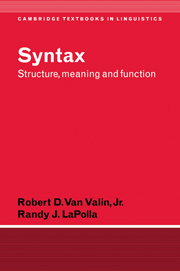Book contents
- Frontmatter
- Contents
- List of figures
- List of tables
- Acknowledgments
- Notes for instructors
- List of abbreviations
- 1 The goals of linguistic theory
- 2 Syntactic structure, I: simple clauses and noun phrases
- 3 Semantic representation, I: verbs and arguments
- 4 Semantic representation, II: macroroles, the lexicon and noun phrases
- 5 Information structure
- 6 Grammatical relations
- 7 Linking syntax and semantics in simple sentences
- 8 Syntactic structure, II: complex sentences and noun phrases
- 9 Linking syntax and semantics in complex sentences
- Epilog: the goals of linguistic theory revisited
- Notes
- References
- Index of languages
- Subject index
3 - Semantic representation, I: verbs and arguments
Published online by Cambridge University Press: 05 June 2012
- Frontmatter
- Contents
- List of figures
- List of tables
- Acknowledgments
- Notes for instructors
- List of abbreviations
- 1 The goals of linguistic theory
- 2 Syntactic structure, I: simple clauses and noun phrases
- 3 Semantic representation, I: verbs and arguments
- 4 Semantic representation, II: macroroles, the lexicon and noun phrases
- 5 Information structure
- 6 Grammatical relations
- 7 Linking syntax and semantics in simple sentences
- 8 Syntactic structure, II: complex sentences and noun phrases
- 9 Linking syntax and semantics in complex sentences
- Epilog: the goals of linguistic theory revisited
- Notes
- References
- Index of languages
- Subject index
Summary
Introduction
In the previous chapter we presented a theory of morphosyntactic structure which elucidated the structure of simple sentences and noun phrases. At many points in the discussion we made crucial reference to predicates and their arguments and to the semantic representation of sentences. Our task in this chapter and the next is to present a theory of just these things. We begin by presenting a classification of the kinds of events, actions and situations that sentences express and of the roles that the participants in these states of affairs may play. We then turn to the problem of representing the relevant semantic properties of verbs and other predicates that code these states of affairs; these representations will in turn form the basis of the semantic representations of clauses and sentences. From these we will derive the representation of the arguments of the verbs and other predicates, arguments which denote the participants in the states of affairs. In the next chapter we will present the notion of ‘semantic macrorole’ and investigate the semantic representation of adjuncts, operators and noun phrases.
A typology of states of affairs and their participants
In chapter 1 we pointed out that the general perspective from which this book is written maintains that the communicative functions of language are central to the analysis of its structure, and one (but not the only) function of language is reference and predication, that is, representing things that happen in the world (or a possible, fictional world) and the participants involved in those situations.
- Type
- Chapter
- Information
- SyntaxStructure, Meaning, and Function, pp. 82 - 138Publisher: Cambridge University PressPrint publication year: 1997

